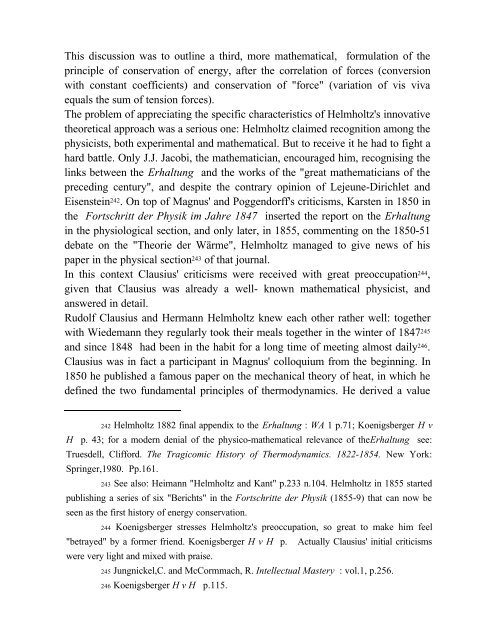Conservation and Innovation : Helmholtz's Struggle with Energy ...
Conservation and Innovation : Helmholtz's Struggle with Energy ...
Conservation and Innovation : Helmholtz's Struggle with Energy ...
You also want an ePaper? Increase the reach of your titles
YUMPU automatically turns print PDFs into web optimized ePapers that Google loves.
This discussion was to outline a third, more mathematical, formulation of the<br />
principle of conservation of energy, after the correlation of forces (conversion<br />
<strong>with</strong> constant coefficients) <strong>and</strong> conservation of "force" (variation of vis viva<br />
equals the sum of tension forces).<br />
The problem of appreciating the specific characteristics of <strong>Helmholtz's</strong> innovative<br />
theoretical approach was a serious one: Helmholtz claimed recognition among the<br />
physicists, both experimental <strong>and</strong> mathematical. But to receive it he had to fight a<br />
hard battle. Only J.J. Jacobi, the mathematician, encouraged him, recognising the<br />
links between the Erhaltung <strong>and</strong> the works of the "great mathematicians of the<br />
preceding century", <strong>and</strong> despite the contrary opinion of Lejeune-Dirichlet <strong>and</strong><br />
Eisenstein 242. On top of Magnus' <strong>and</strong> Poggendorff's criticisms, Karsten in 1850 in<br />
the Fortschritt der Physik im Jahre 1847 inserted the report on the Erhaltung<br />
in the physiological section, <strong>and</strong> only later, in 1855, commenting on the 1850-51<br />
debate on the "Theorie der Wärme", Helmholtz managed to give news of his<br />
paper in the physical section 243 of that journal.<br />
In this context Clausius' criticisms were received <strong>with</strong> great preoccupation 244,<br />
given that Clausius was already a well- known mathematical physicist, <strong>and</strong><br />
answered in detail.<br />
Rudolf Clausius <strong>and</strong> Hermann Helmholtz knew each other rather well: together<br />
<strong>with</strong> Wiedemann they regularly took their meals together in the winter of 1847 245<br />
<strong>and</strong> since 1848 had been in the habit for a long time of meeting almost daily 246.<br />
Clausius was in fact a participant in Magnus' colloquium from the beginning. In<br />
1850 he published a famous paper on the mechanical theory of heat, in which he<br />
defined the two fundamental principles of thermodynamics. He derived a value<br />
242 Helmholtz 1882 final appendix to the Erhaltung : WA 1 p.71; Koenigsberger H v<br />
H p. 43; for a modern denial of the physico-mathematical relevance of theErhaltung see:<br />
Truesdell, Clifford. The Tragicomic History of Thermodynamics. 1822-1854. New York:<br />
Springer,1980. Pp.161.<br />
243 See also: Heimann "Helmholtz <strong>and</strong> Kant" p.233 n.104. Helmholtz in 1855 started<br />
publishing a series of six "Berichts" in the Fortschritte der Physik (1855-9) that can now be<br />
seen as the first history of energy conservation.<br />
244 Koenigsberger stresses <strong>Helmholtz's</strong> preoccupation, so great to make him feel<br />
"betrayed" by a former friend. Koenigsberger H v H p. Actually Clausius' initial criticisms<br />
were very light <strong>and</strong> mixed <strong>with</strong> praise.<br />
245 Jungnickel,C. <strong>and</strong> McCormmach, R. Intellectual Mastery : vol.1, p.256.<br />
246 Koenigsberger H v H p.115.
















